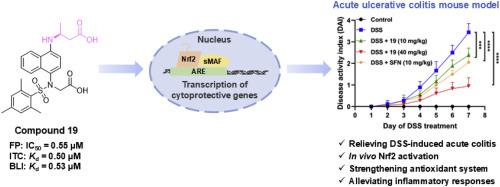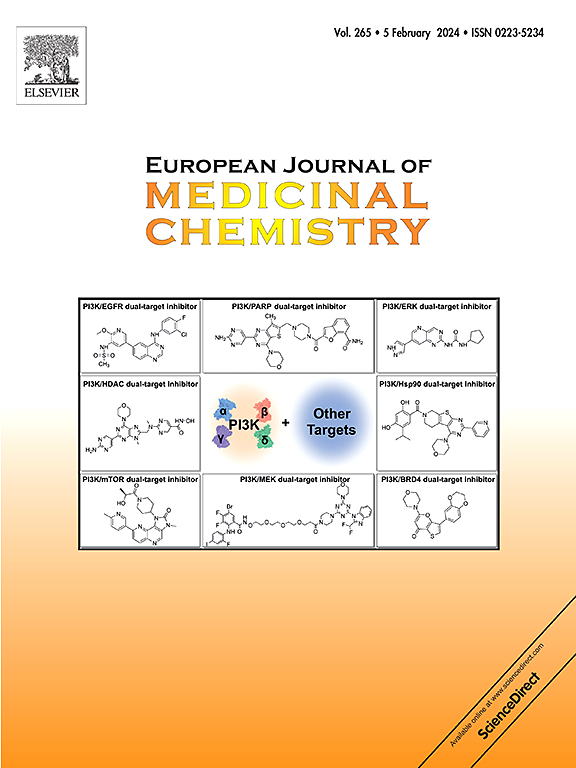Discovery of β-amino acid substituted naphthalene sulfonamide derivatives as potent Kelch-like ECH-associated protein 1−nuclear factor erythroid 2-related factor 2 (Keap1−Nrf2) protein−protein interaction inhibitors for ulcerative colitis management
IF 6
2区 医学
Q1 CHEMISTRY, MEDICINAL
引用次数: 0
Abstract
The transcription factor nuclear factor erythroid 2-related factor 2 (Nrf2) is a key regulator of cellular defense system against oxidative insults. Directly inhibiting the Kelch-like ECH-associated protein 1 (Keap1)−Nrf2 protein−protein interaction (PPI) has emerged as a promising approach to activate Nrf2 for the treatment of diseases associated with oxidative stress. Herein, we identified β-amino acids as privileged structural fragments for designing novel naphthalene sulfonamide-based Keap1−Nrf2 PPI inhibitors. Comprehensive structure−activity relationship (SAR) exploration identified compound 19 as the optimal inhibitor with an IC50 of 0.55 μM for disrupting the Keap1−Nrf2 interaction and a Kd of 0.50 μM for binding to Keap1. Further studies demonstrated that 19 effectively activated the Nrf2-regulated cytoprotective system and provided protective effects against dextran sulfate sodium (DSS)-induced ulcerative colitis (UC) in both in vitro and in vivo models. These findings highlight the potential of β-amino acid substituted naphthalene sulfonamide Keap1−Nrf2 inhibitor 19 as a prospective therapeutic agent for UC via Keap1 targeting.

求助全文
约1分钟内获得全文
求助全文
来源期刊
CiteScore
11.70
自引率
9.00%
发文量
863
审稿时长
29 days
期刊介绍:
The European Journal of Medicinal Chemistry is a global journal that publishes studies on all aspects of medicinal chemistry. It provides a medium for publication of original papers and also welcomes critical review papers.
A typical paper would report on the organic synthesis, characterization and pharmacological evaluation of compounds. Other topics of interest are drug design, QSAR, molecular modeling, drug-receptor interactions, molecular aspects of drug metabolism, prodrug synthesis and drug targeting. The journal expects manuscripts to present the rational for a study, provide insight into the design of compounds or understanding of mechanism, or clarify the targets.

 求助内容:
求助内容: 应助结果提醒方式:
应助结果提醒方式:


